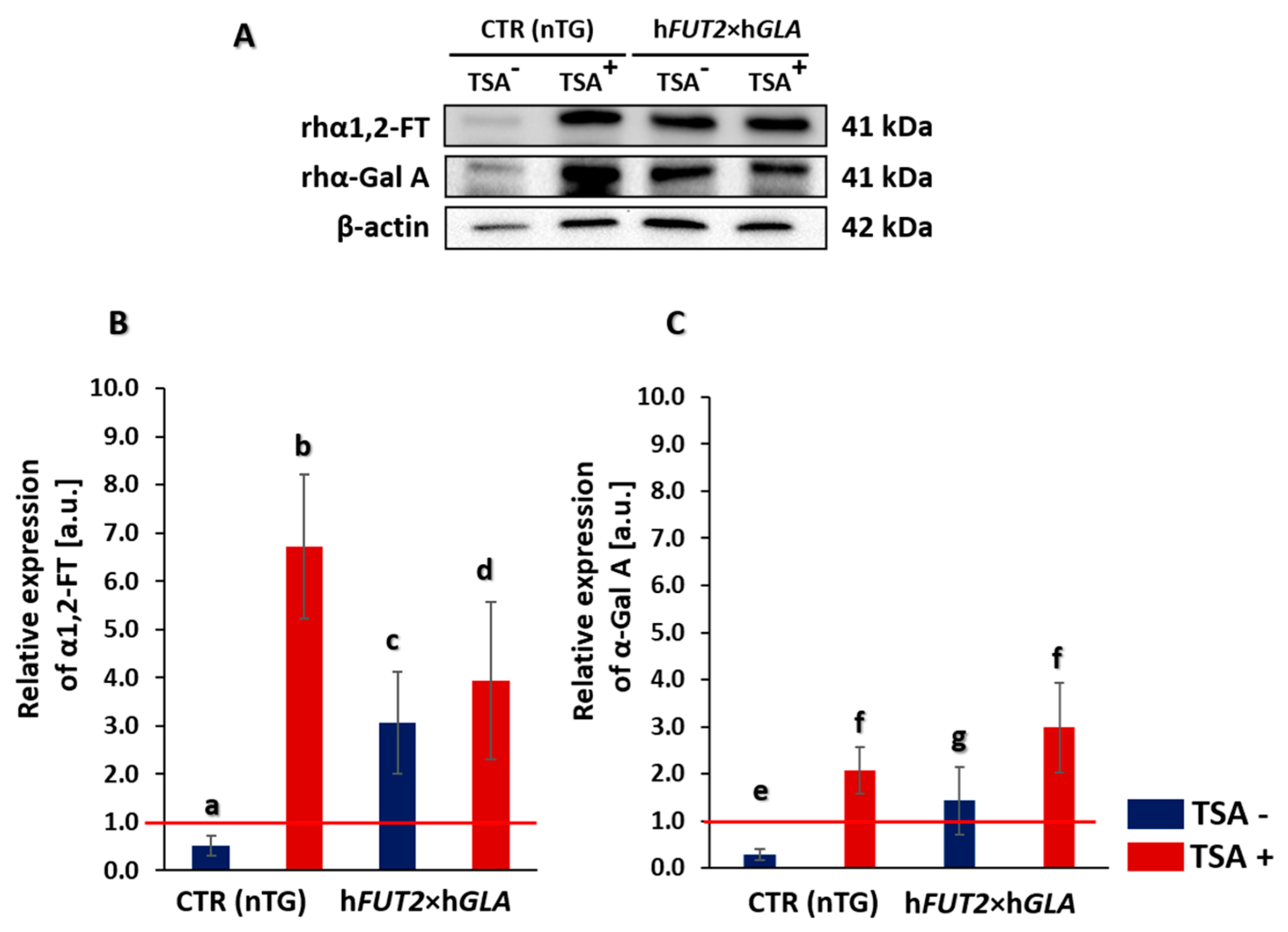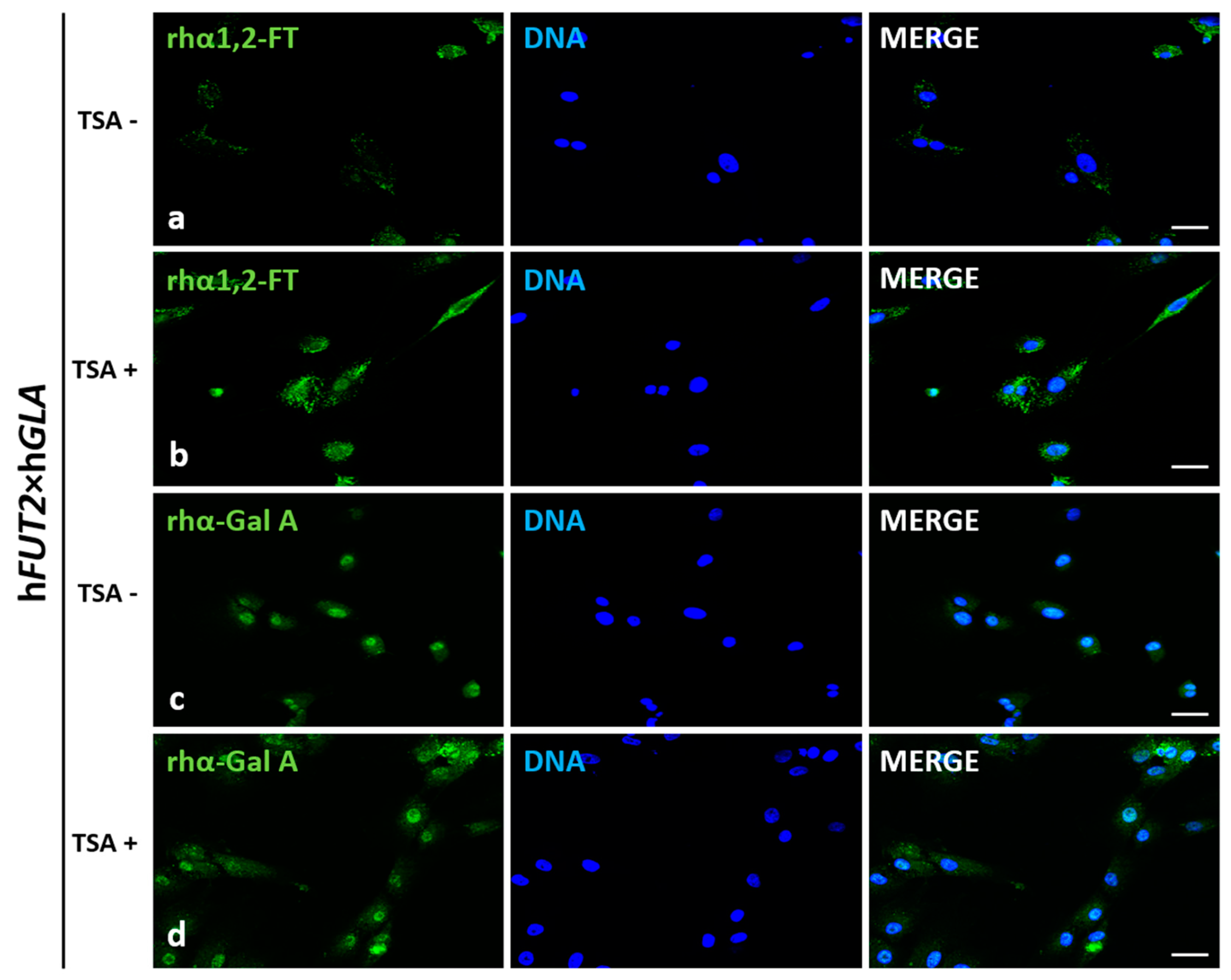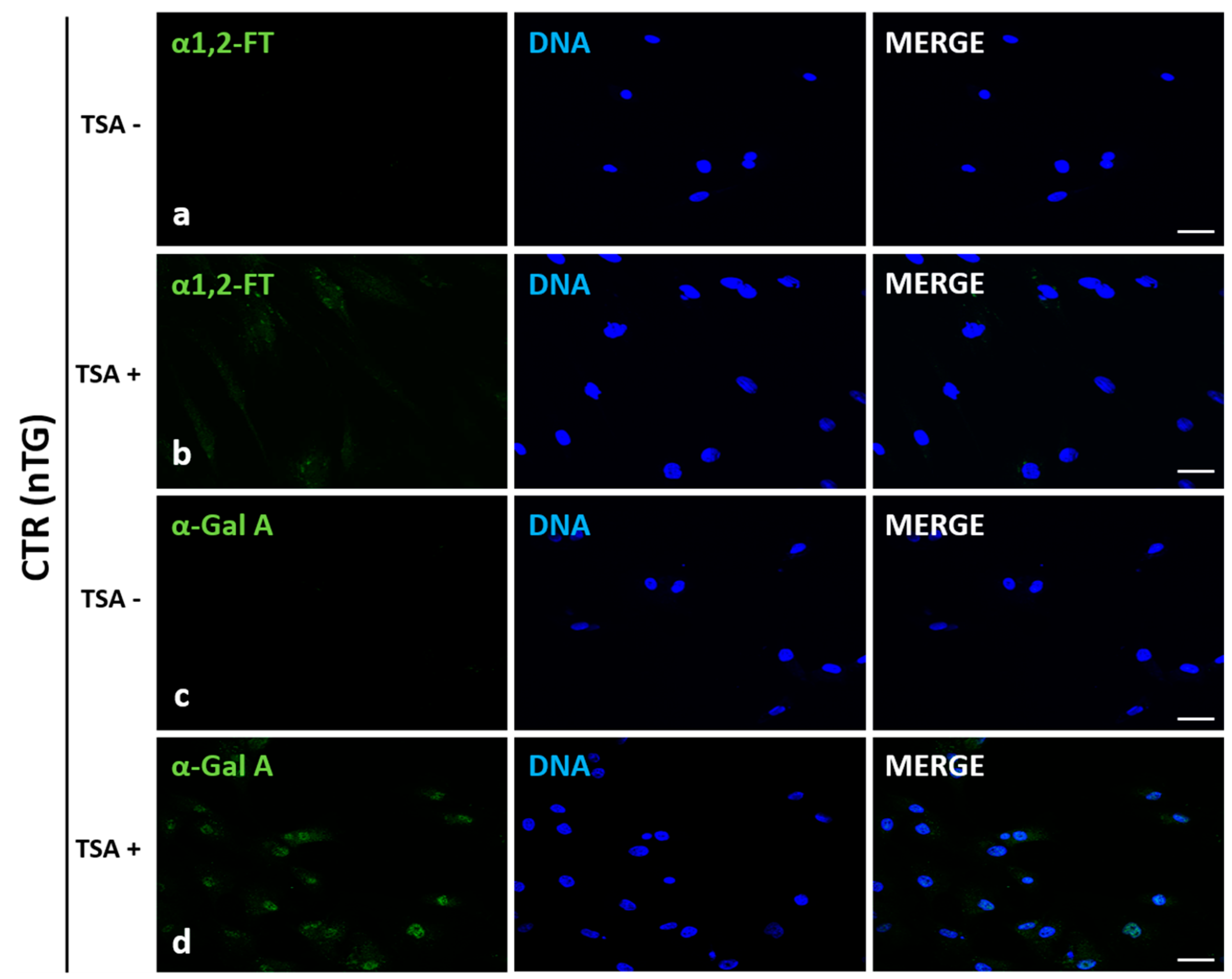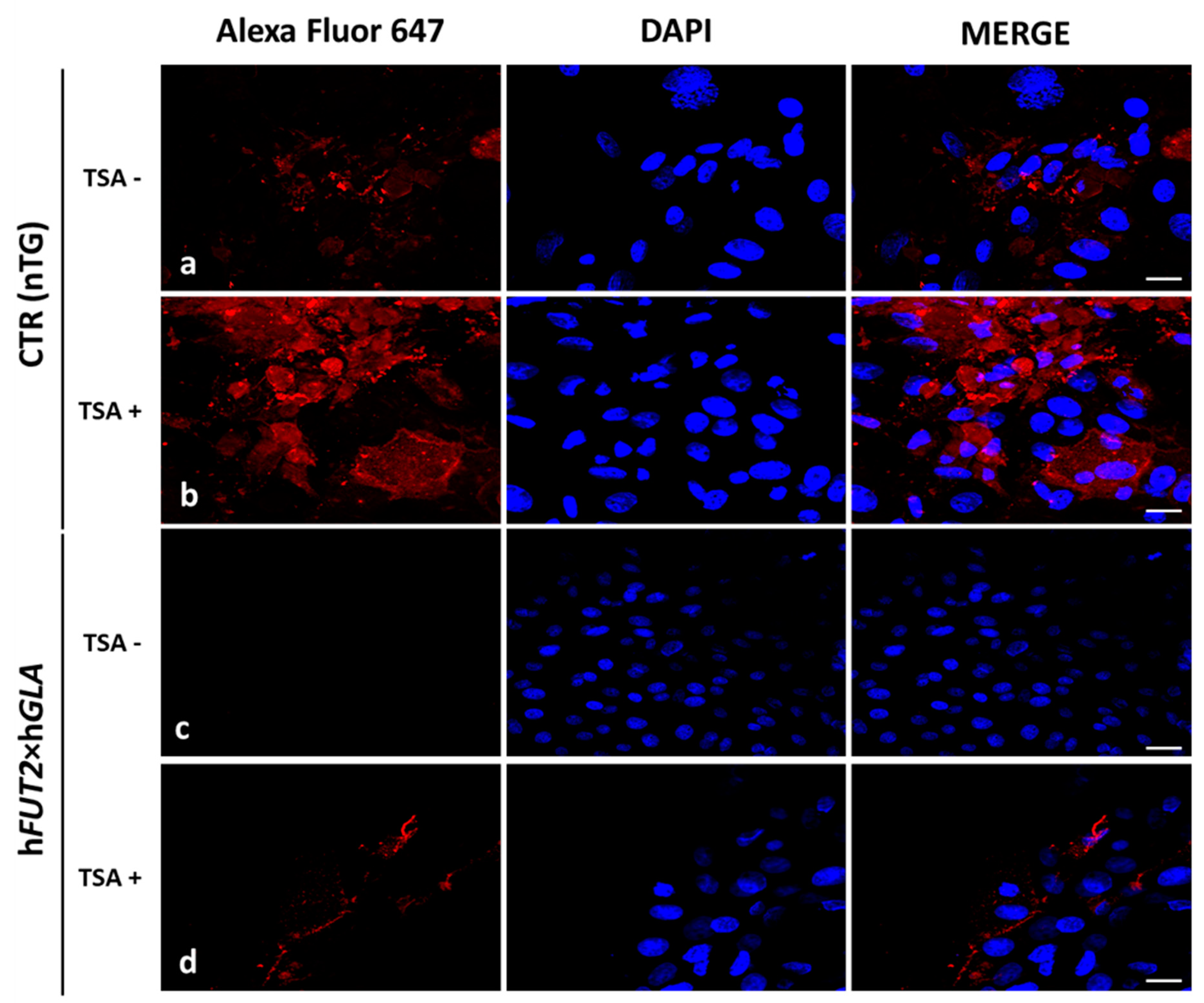Trichostatin A-Assisted Epigenomic Modulation Affects the Expression Profiles of Not Only Recombinant Human α1,2-Fucosyltransferase and α-Galactosidase A Enzymes But Also Galα1→3Gal Epitopes in Porcine Bi-Transgenic Adult Cutaneous Fibroblast Cells
Abstract
1. Introduction
2. Results
2.1. Western Blot Analysis of the Relative Expression of Recombinant Human α1,2-Fucosyltransferase (rhα1,2-FT) and α-Galactosidase A (rhα-Gal A) Proteins
2.2. Immunofluorescence Localization of Recombinant Human α1,2-Fucosyltransferase (rhα1,2-FT) and α-Galactosidase A (rhα-Gal A) in Trichostatin A-Treated and Untreated ACFCs
2.3. Lectin Blotting Analysis of Galα1→3Gal Epitope Expression at the Protein Level in the In Vitro-Cultured Porcine Bi-Transgenic and Non-Transgenic ACFCs Treated and Not Treated with Trichostatin A
2.4. Identification of the Expression Profiles of Galα1→3 Gal Epitope by Fluorescently Labelled Lectin GS-IB4
3. Discussion
4. Materials and Methods
4.1. In Vitro Culture and Trichostatin A-Mediated Epigenomic Modulation of Fibroblast Cells
4.2. Total Protein Extraction and Western/Lectin Blot Analyses
4.3. Immunofluorescence Staining
4.4. Lectin Fluorescence
4.5. Confocal Microscope Analyses
4.6. Statistical Analysis
5. Conclusions
Author Contributions
Funding
Conflicts of Interest
Abbreviations
| ACFCs | Adult cutaneous fibroblast cells |
| DNMTi | Inhibitors of DNA methyltransferases |
| HAR | Hyperacute rejection |
| HDACi | Inhibitors of histone deacetylases |
| HRP | Horseradish peroxidase |
| iPSCs | Induced pluripotent stem cells |
| MSCs | Mesenchymal stem cells |
| rhα1,2-FT | Recombinant human α1,2-fucosyltransferase |
| rhα-Gal A | Recombinant human α-galactosidase A |
| SCNT | Somatic cell nuclear transfer |
| TSA | Trichostatin A |
| α1,3GT | α1,3-galactosyltransferase |
References
- Niemann, H.P. The production of multi-transgenic pigs: Update and perspectives for xenotransplantation. Transgenic Res. 2016, 25, 361–374. [Google Scholar] [CrossRef]
- Cooper, D.K.; Gollackner, B.; Sachs, D.H. Will the pig solve the transplantation backlog? Annu. Rev. Med. 2002, 53, 133–147. [Google Scholar] [CrossRef] [PubMed]
- Galili, U.; Shohet, S.B.; Kobrin, E.; Stults, C.L.; Macher, B.A. Man, apes, and Old World monkeys differ from other mammals in the expression of alpha-galactosyl epitopes on nucleated cells. J. Biol. Chem. 1988, 263, 17755–17762. [Google Scholar] [CrossRef]
- Hryhorowicz, M.; Zeyland, J.; Słomski, R.; Lipiński, D. Genetically modified pigs as organ donors for xenotransplantation. Mol. Biotechnol. 2017, 59, 435–444. [Google Scholar] [CrossRef] [PubMed]
- Whyte, J.J.; Prather, R.S. Genetic modifications of pigs for medicine and agriculture. Mol. Reprod. Dev. 2011, 78, 879–891. [Google Scholar] [CrossRef] [PubMed]
- Cooper, D.K.C.; Ekser, B.; Tector, A.J. Immunobiological barriers to xenotransplantation. Int. J. Surg. 2015, 23, 211–216. [Google Scholar] [CrossRef] [PubMed]
- Blanken, W.M.; Van den Eijnden, D.H. Biosynthesis of terminal Gal α1→3Galβ1→4GlcNAc-R oligosaccharide sequences on glycoconjugates. Purification and acceptor specificity of a UDP-Gal:N-acetyllactosaminide α1→3-galactosyltransferase from calf thymus. J. Biol. Chem. 1985, 260, 12927–12934. [Google Scholar] [CrossRef]
- Osman, N.; McKenzie, I.F.; Ostenried, K.; Ioannou, Y.A.; Desnick, R.J.; Sandrin, M.S. Combined transgenic expression of alpha-galactosidase and alpha1,2-fucosyltransferase leads to optimal reduction in the major xenoepitope Galalpha(1,3)Gal. Proc. Natl. Acad. Sci. USA 1997, 94, 14677–14682. [Google Scholar] [CrossRef]
- Hartel-Schenk, S.; Minnifield, N.; Reutter, W.; Hanski, C.; Bauer, C.; Morré, D.J. Distribution of glycosyltransferases among Golgi apparatus subfractions from liver and hepatomas of the rat. Biochim. Biophys. Acta 1991, 1115, 108–122. [Google Scholar] [CrossRef]
- Luo, Y.; Wen, J.; Luo, C.; Cummings, R.D.; Cooper, D.K.C. Pig xenogeneic antigen modification with green coffee bean α-galactosidase. Xenotransplantation 1999, 6, 238–248. [Google Scholar] [CrossRef]
- Zeyland, J.; Woźniak, A.; Gawrońska, B.; Juzwa, W.; Jura, J.; Nowak, A.; Słomski, R.; Smorąg, Z.; Szalata, M.; Mazurek, U.; et al. Double transgenic pigs with combined expression of human α1,2-fucosyltransferase and α-galactosidase designed to avoid hyperacute xenograft rejection. Arch. Immunol. Ther. Exp. (Warsz.) 2014, 62, 411–422. [Google Scholar] [CrossRef] [PubMed]
- Huan, Y.; Wang, H.; Wu, Z.; Zhang, J.; Zhu, J.; Liu, Z.; He, H. Epigenetic modification of cloned embryos improves Nanog reprogramming in pigs. Cell. Reprogram. 2015, 17, 191–198. [Google Scholar] [CrossRef] [PubMed]
- Samiec, M.; Skrzyszowska, M. Intrinsic and extrinsic molecular determinants or modulators for epigenetic remodeling and reprogramming of somatic cell-derived genome in mammalian nuclear-transferred oocytes and resultant embryos. Pol. J. Vet. Sci. 2018, 21, 217–227. [Google Scholar] [PubMed]
- Saini, M.; Selokar, N.L.; Agrawal, H.; Singla, S.K.; Chauhan, M.S.; Manik, R.S.; Palta, P. Treatment of donor cells and reconstructed embryos with a combination of trichostatin-A and 5-aza-2′-deoxycytidine improves the developmental competence and quality of buffalo embryos produced by handmade cloning and alters their epigenetic status and gene expression. Cell. Reprogram. 2017, 19, 208–215. [Google Scholar] [PubMed]
- Opiela, J.; Samiec, M.; Romanek, J. In vitro development and cytological quality of inter-species (porcine→bovine) cloned embryos are affected by trichostatin A-dependent epigenomic modulation of adult mesenchymal stem cells. Theriogenology 2017, 97, 27–33. [Google Scholar] [CrossRef]
- Silva, C.G.D.; Martins, C.F.; Bessler, H.C.; da Fonseca Neto, Á.M.; Cardoso, T.C.; Franco, M.M.; Mendonça, A.D.S.; Leme, L.O.; Borges, J.R.J.; Malaquias, J.V.; et al. Use of trichostatin A alters the expression of HDAC3 and KAT2 and improves in vitro development of bovine embryos cloned using less methylated mesenchymal stem cells. Reprod. Domest. Anim. 2019, 54, 289–299. [Google Scholar] [CrossRef] [PubMed]
- Oliveira, C.S.; Saraiva, N.Z.; Cruz, M.H.; Mazeti, B.; Oliveira, L.Z.; Lopes, F.L.; Garcia, J.M. HDAC inhibition decreases XIST expression on female IVP bovine blastocysts. Reproduction 2013, 145, 9–17. [Google Scholar] [CrossRef]
- Ikeda, S.; Tatemizo, A.; Iwamoto, D.; Taniguchi, S.; Hoshino, Y.; Amano, T.; Matsumoto, K.; Hosoi, Y.; Iritani, A.; Saeki, K. Enhancement of histone acetylation by trichostatin A during in vitro fertilization of bovine oocytes affects cell number of the inner cell mass of the resulting blastocysts. Zygote 2009, 17, 209–215. [Google Scholar] [CrossRef]
- Laguna-Barraza, R.; Sánchez-Calabuig, M.J.; Gutiérrez-Adán, A.; Rizos, D.; Pérez-Cerezales, S. Effects of the HDAC inhibitor scriptaid on the in vitro development of bovine embryos and on imprinting gene expression levels. Theriogenology 2018, 110, 79–85. [Google Scholar] [CrossRef]
- Kong, P.; Yin, M.; Chen, D.; Li, S.; Li, Y.; Xing, F.; Jiang, M.; Fang, Z.; Lyu, Q.; Chen, X. Effects of the histone deacetylase inhibitor ‘Scriptaid’ on the developmental competence of mouse embryos generated through round spermatid injection. Hum. Reprod. 2017, 32, 76–87. [Google Scholar] [CrossRef]
- Chen, X.; Zhai, Y.; Yu, D.; Cui, J.; Hu, J.F.; Li, W. Valproic acid enhances iPSC induction from human bone marrow-derived cells through the suppression of reprogramming-induced senescence. J. Cell. Physiol. 2016, 231, 1719–1727. [Google Scholar] [CrossRef] [PubMed]
- Zhai, Y.; Chen, X.; Yu, D.; Li, T.; Cui, J.; Wang, G.; Hu, J.F.; Li, W. Histone deacetylase inhibitor valproic acid promotes the induction of pluripotency in mouse fibroblasts by suppressing reprogramming-induced senescence stress. Exp. Cell Res. 2015, 337, 61–67. [Google Scholar] [CrossRef] [PubMed]
- Chen, G.; Guo, Y.; Li, C.; Li, S.; Wan, X. Small molecules that promote self-renewal of stem cells and somatic cell reprogramming. Stem Cell Rev. Rep. 2020, 16, 511–523. [Google Scholar] [CrossRef] [PubMed]
- Mahapatra, P.S.; Singh, R.; Kumar, K.; Sahoo, N.R.; Agarwal, P.; Mili, B.; Das, K.; Sarkar, M.; Bhanja, S.K.; Das, B.C.; et al. Valproic acid assisted reprogramming of fibroblasts for generation of pluripotent stem cells in buffalo (Bubalus bubalis). Int. J. Dev. Biol. 2017, 61, 81–88. [Google Scholar] [CrossRef] [PubMed]
- Rodriguez-Madoz, J.R.; San Jose-Eneriz, E.; Rabal, O.; Zapata-Linares, N.; Miranda, E.; Rodriguez, S.; Porciuncula, A.; Vilas-Zornoza, A.; Garate, L.; Segura, V.; et al. Reversible dual inhibitor against G9a and DNMT1 improves human iPSC derivation enhancing MET and facilitating transcription factor engagement to the genome. PLoS ONE 2017, 12, e0190275. [Google Scholar] [CrossRef]
- Han, B.; Li, J.; Li, Z.; Guo, L.; Wang, S.; Liu, P.; Wu, Y. Trichostatin A stabilizes the expression of pluripotent genes in human mesenchymal stem cells during ex vivo expansion. PLoS ONE 2013, 8, e81781. [Google Scholar] [CrossRef]
- Samiec, M.; Romanek, J.; Lipiński, D.; Opiela, J. Expression of pluripotency-related genes is highly dependent on trichostatin A-assisted epigenomic modulation of porcine mesenchymal stem cells analysed for apoptosis and subsequently used for generating cloned embryos. Anim. Sci. J. 2019, 90, 1127–1141. [Google Scholar] [CrossRef]
- McClure, J.J.; Li, X.; Chou, C.J. Advances and challenges of HDAC inhibitors in cancer therapeutics. Adv. Cancer Res. 2018, 138, 183–211. [Google Scholar]
- Sermer, D.; Pasqualucci, L.; Wendel, H.G.; Melnick, A.; Younes, A. Emerging epigenetic-modulating therapies in lymphoma. Nat. Rev. Clin. Oncol. 2019, 16, 494–507. [Google Scholar] [CrossRef]
- Yoon, S.; Eom, G.H. HDAC and HDAC inhibitor: From cancer to cardiovascular diseases. Chonnam Med. J. 2016, 52, 1–11. [Google Scholar] [CrossRef]
- Kalin, J.H.; Butler, K.V.; Kozikowski, A.P. Creating zinc monkey wrenches in the treatment of epigenetic disorders. Curr. Opin. Chem. Biol. 2009, 13, 263–271. [Google Scholar] [CrossRef] [PubMed]
- Pierson, R.N., III. Antibody-mediated xenograft injury: Mechanisms and protective strategies. Transpl. Immunol. 2009, 21, 65–69. [Google Scholar] [CrossRef] [PubMed]
- Weiss, E.H.; Lilienfeld, B.G.; Müller, S.; Müller, E.; Herbach, N.; Kessler, B.; Wanke, R.; Schwinzer, R.; Seebach, J.D.; Wolf, E.; et al. HLA-E/human b2-microglobulin transgenic pigs: Protection against xenogeneic human anti-pig natural killer cell cytotoxicity. Transplantation 2009, 87, 35–43. [Google Scholar] [CrossRef] [PubMed]
- Crew, M.D.; Cannon, M.J.; Phanavanh, B.; Garcia-Borges, C.N. An HLA-E single trimer inhibits human NK cell reactivity towards porcine cells. Mol. Immunol. 2005, 42, 1205–1214. [Google Scholar] [CrossRef]
- Forte, P.; Baumann, B.C.; Weiss, E.H.; Seebach, J.D. HLA-E expression on porcine cells: Protection from human NK cytotoxicity depends on peptide loading. Am. J. Transplant. 2005, 5, 2085–2093. [Google Scholar] [CrossRef]
- Lipiński, D.; Jura, J.; Zeyland, J.; Juzwa, W.; Mały, E.; Kalak, R.; Bochenek, M.; Pławski, A.; Szalata, M.; Smorąg, Z.; et al. Production of transgenic pigs expressing human a1,2-fucosyltransferase to avoid humoral xenograft rejection. Med. Weter. 2010, 66, 316–322. [Google Scholar]
- Zeyland, J.; Gawrońska, B.; Juzwa, W.; Jura, J.; Nowak, A.; Słomski, R.; Smorąg, Z.; Szalata, M.; Woźniak, A.; Lipiński, D. Transgenic pigs designed to express human α-galactosidase to avoid humoral xenograft rejection. J. Appl. Genet. 2013, 54, 293–303. [Google Scholar] [CrossRef]
- Jia, Y.; Ren, H.; Gao, X.; Ji, S.; Yang, J.; Liu, Z.; Li, S.; Zhang, Y. Expression of human alpha-galactosidase and alpha1,2-fucosyltransferase genes modifies the cell surface Galalpha1,3Gal antigen and confers resistance to human serum-mediated cytolysis. Chinese Med. Sci. J. (Chung-kuo i hsueh k’o hsueh tsa chih) 2004, 19, 31–37. [Google Scholar]
- Wiater, J.; Karasiński, J.; Słomski, R.; Smorąg, Z.; Wartalski, K.; Gajda, B.; Jura, J.; Romek, M. The effect of recombinant human alpha-1,2-fucosyltransferase and alpha-galactosidase A on the reduction of alpha-gal expression in the liver of transgenic pigs. Folia Biol. (Krakow) 2020, 68, 121–133. [Google Scholar] [CrossRef]
- Samiec, M.; Skrzyszowska, M.; Opiela, J. Creation of cloned pig embryos using contact-inhibited or serum-starved fibroblast cells analysed intra vitam for apoptosis occurrence. Ann. Anim. Sci. 2013, 13, 275–293. [Google Scholar] [CrossRef]
- Samiec, M.; Skrzyszowska, M. The use of different methods of oocyte activation for generation of porcine fibroblast cell nuclear-transferred embryos. Ann. Anim. Sci. 2010, 10, 399–411. [Google Scholar]
- Samiec, M.; Skrzyszowska, M. Roscovitine is a novel agent that can be used for the activation of porcine oocytes reconstructed with adult cutaneous or fetal fibroblast cell nuclei. Theriogenology 2012, 78, 1855–1867. [Google Scholar] [CrossRef] [PubMed]





Publisher’s Note: MDPI stays neutral with regard to jurisdictional claims in published maps and institutional affiliations. |
© 2021 by the authors. Licensee MDPI, Basel, Switzerland. This article is an open access article distributed under the terms and conditions of the Creative Commons Attribution (CC BY) license (http://creativecommons.org/licenses/by/4.0/).
Share and Cite
Wiater, J.; Samiec, M.; Skrzyszowska, M.; Lipiński, D. Trichostatin A-Assisted Epigenomic Modulation Affects the Expression Profiles of Not Only Recombinant Human α1,2-Fucosyltransferase and α-Galactosidase A Enzymes But Also Galα1→3Gal Epitopes in Porcine Bi-Transgenic Adult Cutaneous Fibroblast Cells. Int. J. Mol. Sci. 2021, 22, 1386. https://doi.org/10.3390/ijms22031386
Wiater J, Samiec M, Skrzyszowska M, Lipiński D. Trichostatin A-Assisted Epigenomic Modulation Affects the Expression Profiles of Not Only Recombinant Human α1,2-Fucosyltransferase and α-Galactosidase A Enzymes But Also Galα1→3Gal Epitopes in Porcine Bi-Transgenic Adult Cutaneous Fibroblast Cells. International Journal of Molecular Sciences. 2021; 22(3):1386. https://doi.org/10.3390/ijms22031386
Chicago/Turabian StyleWiater, Jerzy, Marcin Samiec, Maria Skrzyszowska, and Daniel Lipiński. 2021. "Trichostatin A-Assisted Epigenomic Modulation Affects the Expression Profiles of Not Only Recombinant Human α1,2-Fucosyltransferase and α-Galactosidase A Enzymes But Also Galα1→3Gal Epitopes in Porcine Bi-Transgenic Adult Cutaneous Fibroblast Cells" International Journal of Molecular Sciences 22, no. 3: 1386. https://doi.org/10.3390/ijms22031386
APA StyleWiater, J., Samiec, M., Skrzyszowska, M., & Lipiński, D. (2021). Trichostatin A-Assisted Epigenomic Modulation Affects the Expression Profiles of Not Only Recombinant Human α1,2-Fucosyltransferase and α-Galactosidase A Enzymes But Also Galα1→3Gal Epitopes in Porcine Bi-Transgenic Adult Cutaneous Fibroblast Cells. International Journal of Molecular Sciences, 22(3), 1386. https://doi.org/10.3390/ijms22031386





